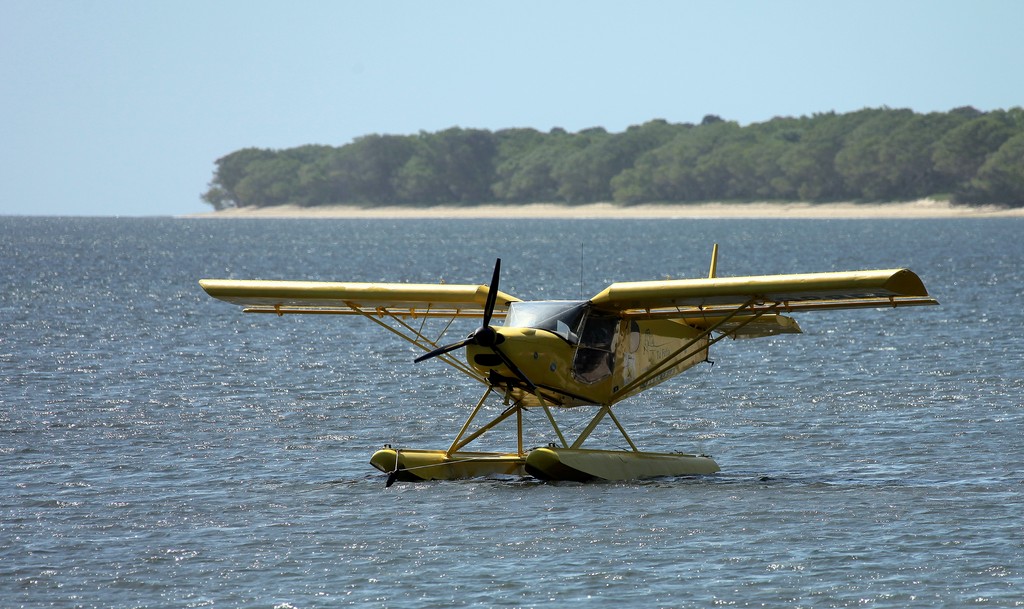CH 701 ZENAIR HYDRAVION
Un hydravion est un avion ayant la capacité de se poser (amerrir) ou de décoller sur l'eau. Deux familles principales d'appareils existent : l'hydravion à coque et l'hydravion à flotteurs.
Le principal intérêt est d'avoir le monde entier comme aérodrome (70 % de la surface de la Terre est recouverte d'eau, et la quasi-totalité de l'humanité vit à moins de 200 km de la mer). Cela peut être utile lors d'une panne nécessitant un amerrissage d'urgence. L'absence de train d'atterrissage n'est pas à négliger car pour les gros appareils, son poids représente de l'ordre de 10 % du poids total à vide. En réalité, la variabilité de l'état de surface des plans d'eau, la corrosion saline en milieu marin, la difficulté d'embarquer les passagers, les performances inférieures des hydravions, les progrès dans la fiabilité des moteurs ainsi que la généralisation de grands aéroports ont eu raison des hydravions, ne leur gardant un rôle que dans des zones géographiques ou des activités très liées à l'eau. Aujourd'hui, les hydravions de gros tonnage pour le transport de fret et/ou de passagers ont totalement disparu.
----------------------------------------------
A seaplane is a powered fixed-wing aircraft capable of taking off and landing (alighting) on water. Seaplanes that can also take off and land on airfields are in a subclass called amphibian aircraft. Seaplanes and amphibians are usually divided into two categories based on their technological characteristics: floatplanes and flying boats; the latter are generally far larger and can carry far more. These aircraft were sometimes called hydroplanes, but currently, this term applies instead to motor-powered watercraft that use the technique of hydrodynamic lift to levitate their main hull above the water when running at speed.
Their use gradually tailed off after World War II, partially because of the investments in airports during the war. In the 21st century, seaplanes maintain a few niche uses, such as for dropping water on forest fires, air transport around archipelagos, and access to undeveloped or roadless areas, some of which have numerous fresh-water lakes.
Numerous modern civilian aircraft have a floatplane variant, usually for light-duty transportation to lakes and other remote areas. Most of these are offered as third-party modifications under a supplemental type certificate (STC), although there are several aircraft manufacturers that build floatplanes from scratch, and a few that continue to build flying boats. Many older flying boats remain in service for firefighting duty, and Chalk's Ocean Airways operated a fleet of Grumman Mallards in passenger service until service was suspended after a crash on December 19, 2005, which was linked to maintenance, not to design of the aircraft. Purely water-based seaplanes have largely been supplanted by amphibious aircraft.
Seaplanes can only take off and land on water with little or no wave action and, like other aircraft, have trouble in extreme weather. The size of waves a given design can withstand depends on, among other factors, the aircraft's size, hull or float design, and its weight, all making for a much more unstable aircraft, limiting actual operational days. Flying boats can typically handle rougher water and are generally more stable than floatplanes while on the water.
Rescue organizations, such as coast guards, are among the largest modern operators of seaplanes due to their efficiency and their ability to both spot and rescue survivors. Land-based aircraft cannot rescue survivors, and many helicopters are limited in their capacity to carry survivors and in their fuel efficiency compared to fixed-wing aircraft. (Helicopters may also be fitted with floats to facilitate their usage on water, though they are not referred to as seaplanes.) These are even more limited in range.
Water aircraft are also often used in remote areas such as the Alaskan and Canadian wilderness, especially in areas with a large number of lakes convenient for takeoff and landing. They may operate on a charter basis, provide scheduled service, or be operated by residents of the area for private, personal use. In the Western Hemisphere, there are numerous seaplane operators in the Caribbean Sea that offer service within or between island groups.
